
Writings About Madeira Wine, Madeira Island & Madeira Wine-Related People
This section contains a number of writings about Madeira Wine, Madeira Island & Madeira wine related people.
Silas Weir Mitchell
Benjamin Franklin
Edward Vernon Harcourt
Viala, Vermorel and the grapes of Madeira
William Neyle Habersham (Coming soon)
Ward McAllister (Coming soon)
Your Madeira Wine Library (Coming soon)
Silas Weir Mitchell: A Madeira Party, first published 1895
The story "A Madeira Party" by Silas Weir Mitchell was first published in 1895. Since then it has been published in about 30 different versions, most often together with a second story "A little more Burgundy". The following text is taken from one of the earliest publications in 1895 from The Century Co., New York, printed by The De Vinne Press.
To my knowledge there is no copyright on the story "A Madeira Party", especially not in this 1895 version. Since "A Madeira Party" was published before January 1st, 1923 I believe it has entered the public domain. Many of Silas Weir Mitchell's other publications can allready be found at the Project Gutenberg in e-book format. But should you know of any still existing copyright please inform me using my email-address from the chapter "Introduction" or the forum.
I used the original text layout and all the typos are exactly from the original (or so I hope). Anybody interested in obtaining "A Madeira Party" as a printed book is advised to get the 1975 edition of Corti Brothers, Sacramento, still available from the company. This book also contains a very interesting essay on "Our Madeira Tradition" by Roy Brady.
Some contents of "A Madeira Party" might not seem "correct" these days, but of course the story has to be seen in its historical context. I find it quite entertaining, especially since it offers an interesting glimpse back into American history. Also for the Madeira wine lover it contains lots of information about old Madeira wine drinking habbits, general knowledge about Madeira wine and some myths about Madeira wine too. And even though I feel very much at home in the 21st century, I envy these guys their full decanters of Madeira wine...
Silas Weir Mitchell: A Madeira Party (1895)
Sometime early in the second quarter of the century, in the City of Penn, and in what was then known as Delaware-Fourth street, soon after dusk in the evening, occurred the unimportant events of which I shall speak.
The room was panelled in white three feet up from the floor, and above this a fox-hunt was repeated in lively colors on every square of the paper which covered the walls. Great hickory logs, ablaze on the deep hearth, cast rosy light on a mantelpiece, in the style of the Directory, pretty with cupids in relief dragging chariots through a tangle of roses. A similar pattern on the ceiling resembled what a visitor to the Zoölogical Gardens may see to-day in the small yellow house called "Solitude", where Mr. Penn is said to have been agreeably naughty and by no means solitary.
Silver and candlesticks lighted a table laid for four, and their light fell on buff and gold Nankin china, glass and glistening plate. A negro servant well on in years, dark as the mahogany he loved to polish, with fine contrast of very white hair, moved to and fro in the room. His task was clearly grateful. To adjust a fork, snuff a wick, flick of the dust off a carved Cupid, evidently gave him a certain grave pleasure. At last, retreating a little with head on one side, artist-like, he considered for a moment the table and the setting. This final survey appeared to be entirely to his liking, for with a smile of satisfaction he turned to inspect a row of decanters on the mantel. One by one he lifted them gently, saw that the glass was clean, and for a moment looked through each decanter in turn as he held it before the light of a candelabrum on the side-table. The necessity to present a wine absolutely free from sediment he very well knew. But it is probable that he also found distinct pleasure in the brilliant gernets and varied amber tints of the several wines before him; for he possessed, like most of his race, an appreciative joy in color, and had, too, more or less artistic pleasure in the prefection of the gleaming table and its perfect appointments. At last he turned to consider the question of the temperature of the precious wines in his charge. Once or twice, when to his touch a decanter seemed too cool, he lifted it with care, moved it to the hearth, and after turning it about before the fire set it back on the mantel. Finally he looked up at the tall Wagstaffe clock in the corner, compared with it a huge silver watch which he took from his fob, and throwing open a pair of mahogany doors, stood aside as four gentlemen enterd the room. Each, as he went by, spoke a kindly word to the old servant. I can fancy the party made a quaint and pleasant picure in the old-fashioned chamber, with their close-fitting nankeen pantaloons, ample shirt-ruffles, voluminous neckties, and brass-buttoned blue coats.
"Pray be seated," said Hamilton. "Sit on my right, Chestnut. I wish to see that my good wine is not wasted. Your first Madeira-drinking will seem strange to you. Thirty years away in Europe! Why, you were but a boy when you left us! Well, we are glad to have you back again."
"And I as pleased to be at home," said Chestnut. As he spoke he noted with the readiness of a close observer of social life the gentlemen about him as they settled themselves at table with an obvious air of contentment. One, a strangely slight and very ruddy old man, after adjusting his napkin over his waistcoat, said, as he looked up, "Well, well, you have lost a good deal of time."
"That is sadly true," said the stranger guest. "I have tasted no Madeiras these twenty years."
"Then I fear, my friend, from what Hamilton tells me, that you will hardly appreciate the charm of one of these little occasions."
"But how could I? And still, let me asure you, my dear Mr. Wilmington, that the importance of the opportunity will not be lost on me, nor the good wine either, sir."
"I trust not," said the elder man. "To consider with care some new Madeiras is - well, for that a man should have perfect health and entiry tranquility of mind. Sir, the drinking of these great wines is something more than a social ceremony or the indulgence of an appetite. It is, sir, - but I see Francis smiling - you may imagine the rest. I had an old friend who, when dying, declined to have his wine whey made out of a famous old Madeira, saying that it was a waste of a good thing on a palate which was past knowing sherry from port. That was, in my opinion, a well bred and judicous use of conscience."
"There was a certain refinement of unselfishness about it," said Chestnut. "I was on the point of asking you if, in your opinion, these finer wines are apt to tempt men into coarser indulgence? I have heard it so said."
"I do not think it," returned Wilmington. "I am well aware, sir, that there are brutes who may make worse pigs of themselves with Madeira, or with anything; but as far as my memory serves me, I recall no occasion, sir, on which I have seen men truly appreciate this wine, the worse for it."
"A pretty strong statement," laughed Francis.
"I hope, sir, you do not mean to doubt -"
"Oh, by no means," cried the other, interupting the irascible old man. "Not I. Pardon me - a thousand pardons!"
"Enough, sir! Thank you," an he bowed formally. "I was saying, or was about to say, when - but, no matter" - and he turned to their host:
"I hope, Hamilton, you have not arranged for a heavy supper."
"How could you suspect me of that? A triffle of terrapin, without wine in the dressing, as a friend gave them to me last week in Baltimore. Then I shall offer you the breast of a canvasback. That is all. For an honest and refined study of Madeiras which are new to the palate, one should have supped wisely and not too well."
"It seems so odd," said Chestnut, "to come back to terrapin and canvasbacks. I was unwise enough to send my French servant yesterday to buy some terrapin, never dreaming he could have any difficulty with a written order, as also he speaks English fairly. He returned with the statement that the old dealer you commended to me would not serve Mr. Hamilton's friend parce qu'il n'avait pas de comtes."
"Is that a true tale, Chestnut?" asked Francis, amid the amusement of the others.
"Yes, it is true. It was explained to me later that the dealer said the terrapin were not counts. I believe my man came back with an obscure idea that terrapin belong to the nobility. He did fetch me some very fine ducks, however."
"Talkking of ducks, my dear Wilmington," said Francis, "tell Chestnut what Wharton said of them at dinner here last week."
The gentleman adressed looked up. His face, on which were many furrows of laughter, grew slowly merry at the remembrance of the jest he was called on to repeat.
"Oh, some of us were rather heavily discussing the duckshooting on the Chesapeake. Wharton does not shoot, and, getting tired of the talk, said quietly, 'Did it ever happen to any of you to go out after Russia duck and get nothing but canvas back?'
For a moment we were all caught by the verbal likelihood of it; but when the laugh came it broke up the duck talk, to Wharton's delight."
"Ah, he said charming things; and now they are mostly forgotten," said the host.
"Well, well", cried Wilmington, "so are the dinner and the wine of last year; but on would have been worse off without them. What was it he said of Colonel M - ? Oh, yes. How the merry ghost of a jest hounts one, and at last recalls the substance! The colonal had been in the army, and later settled on a sugar plantation. Wharton said of him, quoting Burns, ' "His 'prentice han' he tried on man, and then he made the lasses O" ' "
"Delightful!" cried Chestnut.
"Here is the terrapin," said Hamilton; and the supper went on with luxurious simplicity. Next came the ducks, which the host adroitly carved. Then the cloth was removed, the shining candelabra replaced on the polished mahogany table, and a crust of bread on a plate set by each guest. Meantime the talk continued, while Chestnut looked on, much amused at the gravity which of a sudden fell upon the party.
"Olives?"
"No," said Wilmington, declining. "Nothing cleans the palate like bread. For red wines, a peach helps one's taste. Your table is perfect, Hamilton;" and, turning to the servant, "It does you credit, Uncle John. How many a fellow must have rolled under it when it was young! Ah, your old decanters and those coasters could tell some queer tales,"
"A pretty word, 'coaster'," remarked Chestnut. "Coasters delivering wine at human harbors around the table."
"It is not in the dictionaries," said Francis.
"Odd, that," returned Hamilton. "You make like to know, Chestnut, that at this table Washington, Lafayette, and Franklin have dined."
"All Madeira men, I doubt not," said Wilmington; "that accounts for a good deal."
"Perhaps," said the host, smiling. "Ah, I see you glancing at the cigars, Chestnut. But, alas! they are forbidden until the Madeira has been tasted."
"Cigars!" exclaimed Wilmington. "The mere odor in a room destroys the palate."
"I have never held to this belief," said Francis, addressing Chestnut. "But it is common among the lovers of wine. I would like to put Wilmington on oath as to this strange opinion. At least he will permit me to ask him if he believes that smoking affects the taste of all wines?"
"There is but one wine," returned Wilmington.
"And his name is Madeira, of course," laughed Francis. "But there are other juices of the grape which cannot be quite set aside as bastards."
"I might give a little corner of esteem to the highest gardes of Burgundy," said the old gentleman. "No other, not even the finest claret, but is underbred compared to this aristocrat."
"I can't go quite so far as that," said Francis. "Ah, me! Do you remember, Hamilton, that gay day at Dijon, long years ago, in the Hôtel Jura, and the way that old innkeeper fell in love with you, and lavished on us a varied harem of wines ever better and better, until at last you admitted, as to a famous Beaune, that it was equal to any Madeira -"
"What - what - I, sir? No, sir! My judgement must have been disturbed."
"Oh, it is true."
"Well, maybe; but - it is not so to-day," said Wilmington. "There is but one wine. I loved it when I was young; no new mistress can disturb my affections. I never touch it now without a thought of the friends at whom I have smiled a health across it in days long past. For the fool, a wine is wine and nothing more."
"True, true," said Francis. "For me, too, it is a magician. I never lift to my lips a glass of this noble wine without seeing faces that are gone, and hearing the voices and the laughter and the jests that are no more."
"Wine makes poets of us all!" exclaimed Hamilton. "Once I asked Wlimington what he saw, for he was staring down into his glass, and he said he saw memories. By George! we were all as still as mice for a moment. But he is right; there is but one wine, and that, like tobacco, is an American discovery."
"I can talk tobacco with you all day," said Chestnut. "Wine is another matter. We should have a monument to that unknown Indian brave who evolved the pipe. How did he do it? There is the simplicity of genius about it. I can understand the discovery of America, and the invention of printing; but what human want, what instinct, led to tobacco? Imagine intuitive genius capturing this noble idea from the odors of a prairie fire! Surely, Lamb's roast pig was nothing to the discovery of the gentle joy of a wholesome pipe."
"What a droll fancy!" said Francis. "I envy that fellow his first smoke - the first pipe of man."
"My envy," said Chestnut, "is reserved for that medieval priest who by happy chance invented champagne. His first night in the convent wine-cellar with the delicious results of his genius must have been - I wonder no poet has dwelt on this theme."
"We were talking about Madeira," remarked Wilmington, impatiently. "You were about to say, Hamilton, -"
"Only that I am not quite so clear as to our credit for discovering Madeira," said their host.
"No? It is all in Smith's 'Wealth of Nations.' Great Britain allowed no trade with France or Spain; but as to what were called non-enumerated articles we were permitted to trade with the Canary and Madeiras. We took staves and salt fish thither, and fetched back wines. It so happend that the decisive changes of weather our winter and summer afford did more to ripen this wine than its native climate. The English officers during the French war found our Madeiras so good that they took the taste to England."
"And yet," said Chestnut, "Madeira is never good in England. Is it the climate, or that they do not know how to keep it?"
"Both - both," returned Wilmongton. "They bottle all wines, and that is simply fatal. Madeira was never meant to be retailed. It improves in its own society, as greatness is apt to do."
"I myself fancy," said the host, "that despite English usage, even port is better for the larger liberty of a five-gallon demijohn. I tried this once with excellent result. The wine became pale and delicate like an old Madeira."
"How all this lost lore comes back to me as I used to hear it at my father's table!" said Chestnut. "I recall the prejudice against wine in bottle."
"Prejudice, sir?" retorted Wilmongton, testily. "Your demijohn has one cork; your five gallons in bottles, a dozen or two of corks, and the corks give an acrid taste. Some wise old Quaker found this out, sir. That is why there is so little good wine in Charleston and Boston. They bottle their wine. Incredible as it may seem, sir, they bottle their wine."
"That is sad," returned Chestnut, gravely.
"Keep it in demijohns in moderate darkness under the roof," returned Francis. "Then it accumulates virtue like a hermit. I once had a challenge from the Madeira Club in Charleston to test our local theory. They sent me two dozen bottles of their finest Madeira. When we came to make a trial of them, we were puzzled at finding the corks entire, but not a drop of wine in any of the bottles. At last I discovered that some appreciative colored person had emptied them by the clever device of driving a nail through the hollow at the base of the bottles. I found, on experiment, that it could easily be done. A letter from my friends forced my to tell the story. I fancy that ingenious servant may have suffered for his too refined taste."
"But he had the Madeira," said Wilmington grimly, glancing at the old servant. "I have no doubt Uncle John here has a good notion of Madeira."
The old black grinned responsively, and said, with the familiarity of an ancient retainer, "It's de smell ob it, sar. Ye gets to know 'em by de smell, sar."
"That is it, no doubt," laughed Francis. "By and by we shall all have to be content with the smell. It is becoming dearer every year."
"I found yesterday," said Hamilton, "an invoice of fiftyeight pipes of Madeira, of the date of 1760. The wine is set down as costing one dollar and four cents a gallon. I should have thought it might have been less, but then it is spoken of as very fine."
"My father," returned Wilmington, "used to say that the newer wines in his days were not much dearer than good old cider. They drank them by the mugful."
"I remember," said Francis, "that Graydon speaks of it in his 'Memoirs.' "
"Who? What?" creid Wilmington, who was a little deaf. "Oh! Graydon - yes, I know the man and the book, of course, but I do not recall the passage."
"He says: 'Our company' - this was in 1774 - 'our company was called "The Silk-Stocking Company." The place of rendezvous was the house of our captain (footnote by the editor of the publication: Afterward General John Cadwalader), where capacious demijohns of Madeira were constantly set out in the yard, where we formed for regular refreshment, before marching out to exercise.' He was most amusing, too, as to why the captain was so liberal of his wine; but I can't quite recall it, and I hate to spoil a quotation. You would find the book entertaining, Chestnut."
"How delightful!" exclaimed Chestnut. "Capacious demijohns in the yard, and the descendants of Penn's Quakers - anti-vinous, anti-pugnacious Quakers - drilling for the coming war! By George! one can see it. One guesses that it was not out of such fairy glasses as these they drank the captain's Madeira."
"I am reminded," cried Hamilton. "that I have a letter of the captain's brother, Colonel Lambert Cadwalader, to Jasper Yeates, at Lancaster, in 1776. It is interesting. Wait a moment; I will get it." And so saying, he left the table, and presently returning said, "I will read only the bit about the wine. It shows how much store they set by their good wine even in those perilous days.
"Take particular care of the red chest clampt with iron herewith sent, which contains some bonds and mortgages which I could not take out, the key being lost; and also that you would be kind enough to let the two quartercasks of Madeira, painted green, be deposited in some safe place under lock and key in your cellar, if possible where you keep you own liquors in a safe place, as I value them more that silver and gold in these times of misfortune and distress.
"Then he goes on to tell the news of Washington's victory at Trenton."
"What a glimpse at the life of those days!" said Chestnut.
During the chat the servant had placed before the host a half-dozen quart decanters filled with wines of various hues and depth of color.
"And now for the wine! We have been losing time," exclaimed their host.
As he spoke, the servant set on either side of the fire a brass-bound, painted bucket in which were a number of decanters - the reserve reinforcements to be used if the main army gave out. Meanwhile the desultory chat went on as the servant distributed the glasses. These were arranged in rather odd fashion. In the center of the table was set a silver bowl of water. The notches in the rim received each the stem of an inverted glass. Before every guest a glass bowl, much like a modern finger-bowl held also two wine-glasses. Thus there was to be a glass for each wine, or at need the means for rinsing a glass.
The talk had been more entertaining to the younger men and their host than to Wilmington. He had come for the purpose of tasting wines, and was somewhat annoyed at the delay.
"Dined with Starling last week," he said. "Never was more insulted in my life, sir. Had his after-dinner wine - all of it, sir - in pint decanters!"
"Not, really?" said Francis, with a seriousness by no means assumed. "In pints!" You are quite sure you are correct?"
"Fact, sir."
"I - !" exclaimed Chestnut. "Pardon me; but I fail to see the insult."
"What! You, sir! Your father's son! Gentlemen do not serve wine in pints after dinner. They don't do it; and the wine was bad - sick, thick!"
"Ah, I see. I have been long enough away to have forgotten many things. As to these wines you all discuss so critically, I have tasted some of them of late, and they seemed to me much alike."
"Alike, sir! You surprise me," said Wilmington. "I pity you. What a waste of opportunities! But it is not to late to reform - to learn. I know one man who made a quite correct palate at the age of forty - not a gentleman, either; and that's rather remarkable."
"And is that so rare?" cried Chestnut, much delighted.
"Oh, very," said Francis.
"I knew the man," returned Hamilton. "He died somewhat early. However, I have noticed that the acquisition of a taste for Madeira in middle life is quite fatal to common people."
"Is that so?" said Chestnut, greatly enjoying it all. "Upon my word, I still have a dim memory of all this stuff about wine, as I used to hear it when a lad. I thought it had gone with other superstitions. To be frank, I have so little trust in tales I hear every day after dinner, about wine and wine-tasting, that - "
"Pardon me," interupted Wilmington. "Of course you can hear much that is foolish; but to my mind the real facts are often interesting."
"Such as -?" asked Chestnut. "Pray tell me."
"Hamilton will indorse this as an illustration. He was one of eight gentlemen - of whom three are here now - who were asked to give judgment on certain wines. Each man wrote his opinion as to the value, age, and quality of each specimen, and folding over the paper passed it with the wine. Finally, Hamilton read aloud each statement. The estimated price, or value, of a demijohn - that is of five gallons - of each was given; the age, the character, the defects, and so on. The prices assigned to the grape-juices varied much, because most of us cared for them but little. As to the Madeiras pure and simple, the conclusions as to the value, age and quality were so very much alike as even to surprise some of us."
"It is, I suppose," said Chestnut, who began to take a more serious interest, "a matter of habit - acquired habit - and attention."
"No," said Hamilton. "Far more it is a gift. Some women have it wonderfully."
"But, after all," said Francis, "why should appreciative delicacy of the palate amaze us more than sharpness of vision or delicacy of touch?"
"Only because a fine taste is, of all forms of sensory acuteness, the rarest," returned Hamilton. "It is still more uncommon to have a perfect memory of taste, while odors are so easily remembered.
"I have known certain persons in whom refined delicacy of palate was accompanied with an almost incredible remembrance of past impressions as to the taste of things. Our good old friend Mr. C - , as we all know, could recall a particular coffee or tea he had tasted years ago; could say what wines had been by accident mixed in the Madeira he drank; and was able to declare, as a test of his singular skill, in which of two clean wine wine-glasses a boiled egg had been placed a day or two before."
"It is interesting," said Chestnut; "but to me, if not incredible, it is at least made almost so by my own deficiencies."
"Well, now, to reëducate you," said Hamilton, "let us exchange theory for practice." So saying, he put on his spectacles, and began to scan the silver labels on his decanters, and to rearrange the order of the row of wines, so as to present them somewhat as opinions are given in a council of war - the least esteemed first. Meanwhile he said: "Wilmington likes his wine cool. It is a grave question. I prefer it a triffle above the temperature of the room. It insures a more perfect presentation both of the taste and smell. A little chill may cloud the wine, or repress its bouquet. We are all agreed that the wine should be at rest in a warm room some days; or longer, before it is drunk. Nothing mellows a wine like that. And then one must be careful not to have wine shaken; that bruises it. But this is commonplace, Chestnut; I am merely giving you a preliminary education. I think you will find these Madeiras in good condition, carefully drawn and bright. I ought to add that they are all drawn with the siphon, so as not to disturb the salts which cristallize on the sides of the demijohn, or the deposit every wine lets fall, as a good man drops his faults as he goes on in life."
"Just a word before we take our wine, " said Francis. "I saw Chestnut smile at the idea of a wine being bruised. I can tell him a story about that. We were dining at the Quoit Club, in Germantown, and were at the table when Wilmington, who was in the habit of riding out to the club, arrived somewhat late. We came by and by to the Madeiras. I saw the general taste a wine, as if in doubt. At last he looked up, and said: 'Wilmington, this wine is bruised; you brought the bottle out in your coat-tail pocket - the left pocket.' We were soon convinced as to the wine having been thus shaken out of health; but his inference as to the left pocket puzzled us all, until the general asked some one to stand up, and to put a bottle in his own coat-tail pocket. Then the reason of my friend's conclusion became clear enough - however, I delay the wine."
"Well, here it is," said Hamilton, filling his glass. Then he passed the decanter to Wilmington, on his left, saying, "With the sun, gentlemen."
"A fair grape-juice," said the latter; "but a triffle too warm."
"And what," said Chestnut, "is a grape-juice? All wines are merely that."
"Oh, usually it is the product of the south side of the island, sometimes of one vineyard, but untreated by the addition of older wines; sweet of course; apt to be pale. When a Madeira-drinker speaks of a grape-juice, that is what he means. But a Madeira - what we call simply a Madeira - is apt to be dry, and usually is the result of careful blending of wines and some maturing by natural heat."
"But in time," said Chestnut," your grape-juice becomes a Madeira. Certainly this is delicious! How refined, how delicate it is!"
"Ah, you will learn," cried Wilmington. "But wait a little. A grape-juice never becomes what we denominate a Madeira."
"I don't agree with you," said the host.
"We are in very deep water now," laughed Francis. "I, myself, think the finest of the old dry Madeiras were once sugary maidens."
"Nonsense," said Hamilton, passing the next wine. "With the sun."
"Why with the sun?" said Chestnut, infinitely delighted by these little social superstitions and the odd phrases.
"Because it sours a wine to send it to the right," said Wilmington, dryly. "That is a fact sir, - a well-known fact."
"Droll, that," retuned Chestnut. "I wonder whence came that notion."
"It is a pretty old one; possibly Roman. The Greeks passed their drink to the right. Wine is a strange fluid. It has its good and its bad days."
"I am willing to say its moods," added Hamilton.
"I suppose," continued the older man, "that you will be entirely sceptical if I assure you that for women to go into a wine-room is pretty surely to injure the wine."
"Indeed, is that so?" returned Chestnut. "I am not surprised. In France women are not allowed to enter the great cheese-caves."
"Wine is very sensitive," said Francis. "I give you this story for what it is worth:
"A planter in the South told me that once two blacks were arranging bottles in his wine-room, and quarreled. One stabbed the other. The fellow died, and his blood ran over the floor; and from that day the wines in the room were bitter. You know that bitterness is one form of sickness to which Madeira is liable."
This amazing tale was received with entire tranquility by all save Chestnut, whose education was progressing. Meanwhile another decanter went round.
"I congratulate you," cried Wilmington, as he set down his glass. "A perfect grape-juice - new to me too. High up, sir; very high up"; and refilling his glass, he sent on the coaster. "Observe, Chestnut, the refinement of it; neither the sweet nor the bouquet is too obvious. It is like a well-bred lady. Observe what a gamut of delicate flavors; none are excessive. And then at last there remains in the mouth a sort of fugitive memory of its delightfulness."
"As one remembers the lady when she is gone," said Francis.
"Thanks," said the old gentleman, bowing.
"Am I wrong," said Chestnut, "in fancying that there is here a faint flavor of orange-water?"
"Well, well!" said Wilmington. "And this man says he has no palate! That is the charm of these lovely wines: they are many things to many lovers - have for each a separate enchantment. I thought it was a rose-water taste; but no matter, you may be correct. But Hamilton can give you a better wine. No grape-juice can compete with the best Madeiras. In wine and man the noblest social flavors come with years. It is pure waste to ask to dinner any man under forty."
"And now fill you glasses," said Hamilton. "Are you all charged? Your health, gentlemen! I waited for this wine;" and he bent his head to each in turn.
"That good old formula, 'Are you all charged?' is going out," said Chestnut. "I used to hear it when I came in to dessert at my father's table."
"One rarely hears it nowadays," remarked Francis. "But at the Green Tree Insurance Company's dinners it is still in habitual use. When the cloth is off, the President says, 'Are you all charged, gentlemen?' and then, 'Success to the Mutual Insurance Company.' You know, Chestnut, its insurance sign - still to be seen on our older houses - is a green tree. The Hand in Hand Insurance Company refused to insure houses in front of which were trees, because in the last century the fire-engines were unable to throw a stream over or through them. The Mutual accepted such risks, and hence has always kown popularly in Philadelphia as the Green Tree. After a pause, the Vice-President rises and repeats the formal query, 'Are you all charged, gentlemen?' The directors then stand up, and he says, 'The memory of Washington.' We have a tradition that the news of the great general's death in 1799 came while the Board of Directors was dining. From that time until now they have continued to drink that toast."
"I like that," said Chestnut. "These ancient customs seem to survive better here than elsewhere in America."
"That is true," returned Hamilton. "And what you say reminds me of some odd rules in the Philadelphia Library, which Franklin founded in 1731. We have - at our own cost, of course - a supper of oysters roasted in the shell at the wood fire in the room where we meet. A modest bowl of rum punch completes the fare. Old Ben was afraid that this repast would degenerate into a drinking-bout such as was too common in his time. He therefore ingeniously arranged a table so high that is was impossible to sit at it, and this shrewd device seems to have answered."
"When I became a director of the library," said Francis, "my predecessor had been ill for two years. As a consequence, he was fined a shilling for non-attendance at each meeting. This, with the charges for suppers, and for the use of the library as a stockholder, had accumulated a debt of some fifty dollars. Now, as Franklin found it difficult to collect such debts from estates, he made it a rule that the new director, while pleased with the freshness of his novel honor, should pay the bill of the man he succeeded; and accordingly I paid my predecessor's debts."
"How like poor Richard!" said Wilmington.
"I was consoled," added Francis, "by the reflection that I always had the sad privilege of leaving my successor a similar obligation."
"Agreeable, that," murmured Wilmington. "But we are trifling, my dear Francis. What is next, Hamilton? Ah, a new wine. That is a wine indeed! A Madeira. Stay! I have drunk it before. A Butler wine, is n't it?"
"Yes. I misplaced the decanters; this should have come later."
"I see now," said Chestnut. "What is this curious aftertaste? Prunes? Is n't it prunes?"
"Certainly," cried Hamiton. "You are doing well, Chestnut. These noble old wines have a variety of dominant flavors, with what I might call a changeful halo of less decisive qualities. We call the more or less positive tastes apple, peach, prune quince; but in fact these are mere names. The characterizing taste is too delicate for competent nomenclature. It is a thing transitory, evanescent, indefinable, like the quality of the best manners. No two are alike."
"Yes," said Hamiton; "and this same wine, in bottles, after a few years would lose character. Even two demijohns of the same wine kept in one room constantly differ, like two of a family."
"As you talk of these wines," said Chestnut, "I dimly recall the names of some I used to hear. 'Constitution' a Boston wine, was one -"
"And a good vintage, too," said Hamilton. "It was the class wine of 1802."
"The class wine?" queried Chestnut.
"Yes. At Harvard each class used to import a tun of wine, which, after it was bottled, was distributed among the graduates. I still have two of the bottles with '1802' surrounded by 'Constitution,' molded in the glass."
"A good wine it was," added Francis. "I know of no other which has been hurt so little by being bottled."
"There were others I used also to hear about. One, I think was called 'Resurrection' - a wine burried for protection in the war; but some of the names of these wines puzzle me."
"The Butlers," returned Francis, "of course represent in their numbering the successive annual importations of Major Pierce Butler for his own use. Some wines were called from the special grape which produced them, as Bual, Sercial, Vidogna. As to others, it was a quality, as in the case of the famous applewine; or the name of the ship in which the wine came to us, as the Harriets (pale and dark), the Padre; others again were wines long held by families, as the Francis, Willing, Butler and Burd Madeiras."
"Might I ask how long may a Madeira live, and continuously gain in value for the palate?"
"Ah, that depends on the wine," said Hamilton. "I never drank a wine over seventy years old which had not something to regret - like ourselves, eh, Wilmington?"
"I have nothing to regret," returned the elder man, smiling, "except that I cannot live my life over precisely as it was. I have neglected no opportunity for innocent amusement, nor - " and he paused.
"For some others," added Francis, amid a burst of laughter.
"I fancy," said Chestnut, "that Mr. Wilmington is of the opinion of Howell. You will find it in those letters of his which Walpole loved."
"And what was that?"
"It is long since I read it. I am not quite sure I can repeat it accurately. He contends in a humorous vein for the moral value of wine - I think he is speaking of Canary. 'Of this,' he says, 'may be verified that merry induction - that good wine makes good blood; good blood causeth good thoughts; good thoughts bring forth good works; good works carry a man to heaven: ergo, good wine carrieth a man to heaven.' "
"It sounds like one of Shakespere's fools," said Hamilton.
"I should like to read that book," added Wilmington.
"It is at your service," replied Chestnut; "and what else he says of wine is worth reading."
"Then let us get nearer to good works," laughed their host. "Here is a pleasant preacher. Try this."
"Ah," said Wilmington; "a new friend! Curious, that. Observe, Chestnut, the just perceptible smoke-flavor - a fine, clean-tasting, middle-aged wine - a gentleman, sir, a gentleman! Will never remind you to-morrow of the favor he did you last night."
"Needs time," said Francis, "and a careful fining - a little egg-shell and the white of one egg."
"One might risk it," said Wilmington. "But I would rather use milk for fining. It is more delicate, and the wine recovers sooner, unless the dose of milk be too large. But above all, Hamilton, be careful about the moon. A summer fining might be better, but touch it lightly."
"What on earth has the moon to do with it?" said Chestnut.
"If you want to spoil a Madeira," answered Wilmington, "fine it at the change of the moon. I spoiled my dark Harriet that way. Always fine a wine during the decline of the moon."
"I shall call this wine 'Smoke,' " said Hamilton. "Its name is really Pallido. Certainly it has a great future. No better wine ever coasted along the shores of this table, and it has seen many vinous voyages. And now for a very interesting vintage. A little more bread, John. 'With the sun.' "
Wilmington ate a morsel of bread, rinsed a glass in the bowl before him, filled it to the brim, and slowly emptied it. Then he set it down deliberately.
"That is not Madeira, Hamilton; that is sherry. Some mistake."
"What!" cried Francis. "Wrong for once! It is Madeira, and old, - too old, I should say."
Hamilton laughed.
"I thought I should puzzle you. I have but little of it left, and it is new to all of you. Two generations have disputed its parentage."
"I might be mistaken," said Wilmington. "There are Madeiras so like some rare sherries as to puzzle any palate."
"I myself," said Hamilton, "have an inherited belief that it is Madeira. It is difficult to tell, at times, a very old Madeira from a very aged sherry. The Burd wine was remarkable because no one could decide this question. I have heard an old friend remark that the age of all great wines brought them together as to taste. Thus a certain Charles March grapejuice and Blue Seal Johannisberger were scarcely to be told apart."
"I leave you to settle it," said Chestnut, rising, well aware how long the talk would last. "The knowledge I have acquired has, of a verity, gone to my head, - I suppose because, as Miss M- says, nature abhors a vacuum. Thank you for a delightful evening."
"But sit down for five minutes," said Hamilton, who had risen with his guest. "There is a beautiful story about this wine. I must tell it, even if it be familiar to Wilmington as his own best joke."
"Delighted," said Chestnut, resuming his place.
"Well," said Hamilton, "I will not keep you long. This wine came ashore on Absecom Beach from a Spanish wreck, about 1770. Then it was brought to Trenton, and my great-uncle bought it. All but a demijohn was burried in his garden at the old house, not far away from Princeton, to keep it out of British stomachs. The one demijohn kept for use made the mischief I shall tell you of.
"Try that grape-juice, Wilmington. No? Then let Francis have his cigar. My Cuban friend shocks me with the late rise of prices. Eighteen dollars a thousand makes one hesitate."
"It does indeed," said Francis. And soon the room was hazy with delicate smoke, as Hamilton continued:
"It was during the war, you know. My great-uncle Edward, who was with Washington, heard that his wife was ill. He got leave, managed to cross the Delaware, and in his citizen's clothes made his way to his own country-house near Princeton. There he learned that she was not seriously ill, and as the country was full of British scouts, he resolved to go back next day to his duties in Washington's camp. The friend who had aided his adventure and was to set him across the Delaware again, came in about nine of the evening; and to aid them with the wisdom which is in wine, the demijohn of the disputed wine was brought out. Also a noble bowl of rum punch was brewed, and divers bottles were allowed their say, so that when Mr. Trent departed, Uncle Ned retired in some haste lest he should not be able to retire at all. It is probable that he left the candles to burn, and the hall door to close itself. About three in the morning, having snored off his rum and some wine, and hearing a noise, he put on his boots and a wrapper, and taking his pistols, went down-stairs. As he entered the dining-room there were candles burning, fresh logs on the fire, and facing him sat an English captain, with his dirty boots on my aunt's best Chippendale arm-chair, and in act to swallow a glass of wine. Uncle Ned stepped through the open door and covered the unexpected guest with his pistol, at the same time remarking (and he was really the most imperturbable of men), 'Perhaps you are not aware that you are making free with my best Madeira, and really -'
" 'Don't shoot, I beg you, until I finish my glass,' said the captain, calmly. 'Did I understand you to say Madeira? Madeira! It's a sherry - unmistakable sherry! Of course, I don't dispute the ownership.'
" 'Very kind of you,' remarked Uncle Ned. 'There seems to have been a considerable transfer of ownership.'
" 'That is so,' replied the captain. 'I am like Mary after she ate her lamb. "Everywhere that Mary went that lamb was sure to go." Permit me to apologize. The sherry -'
" 'I have had the honor to asure you that it is Madeira.'
" 'Madeira! Great George!'
"Now Uncle Ned hated the king, and loved his wife, and greatly honored his own taste in wine. Both his prejudices and his affection had been lightly dealt with, so he said tartly: 'There is only one Great George, and he is across the Delaware, and the wine is Madeira, and you have soiled my wife's chair; and I wait, sir, to learn your errand.'
" 'I grieve, sir, to say that you will quite too soon know my errand, when I call up the troopers who are back of the house; or if you are in a haste a shot from you will do so as well. Meanwhile permit me most humbly to apologize to Mrs. Hamilton. I regret to continue to differ concerning the wine. As to your George, he is a very small rebel George. And now I am obliged most reluctantly to finish my unfortunate business; perhaps, however, we had better see the last of the wine; you may not have another opportunity.'
"These remarks somewhat sobered Uncle Ned, and he became of a sudden aware of the trap he was in. So he sat down, with his pistols convenient, and saying, 'With all my heart,' began to push the bottle. The Britisher was good company, and his temper was already so mellowed by wine that he was fast nearing the state of abrupt mental decay which mellowness naturally precedes. He graciously accepted a tumbler of punch, which my uncle contrived to make pretty strong, and then numberless glasses of wine, enlivened by very gay stories, at which my uncle was clever. At last the captain rose and said with some gravity, 'The glasses appear to be all t-twins. We have made a night of it. When you make a n-night of it you improve the s-shining hours. And now my painful duty-'
" 'One glass more,' said my uncle; 'and about that story. Pray pardon me, I interupted you.'
" 'Oh, yes,' said the captain, emptying a very stiff glass of rum punch, which by no means put its own quality into the lessening vigor of his legs. 'As I was saying, I knew a man once - very clever man; loved a girl - very clever girl. Man consumedly fond of liquor. Girl did n't know which he liked best, the wine or the woman. One day that girl - he told her a very foolish story about not askin' for wine if she would put a k-kiss in the glass. And that day, instead of a k-kiss she put a little note inside the decanter; and when he had drunk up the wine, and the men were laughing at this f-fashion of billet-doux, he broke the decanter with the poker and r-read the note. Give you my word, he never drank a drop after that; and the note, it was a very c-clever note, and it just said-' But at this moment the captain made a queer noise in his throat, and he slipped down, overcome with rebel rum and much Madeira. Uncle Ned humanely loosened his cravat and sword-belt, and lost no time in creeping through the dark to his friend's house, where he found clothes and a good horse. He was back in camp next day."
"And so this was the wine," said Chestnut; "and the man and the maid are gone, and the wine is still here. But the end of the story? - what the girl said in her note?"
"Ask the wine," laughed Hamilton, "or ask some good woman. No man knows. We shall find Mrs. Hamilton and my daughters in the drawing-room. They must be at home by this time. You can ask them."
"With all my heart, " said Chestnut.
"That is, if you have had enough tobacco," added the host.
"Just one more glass from the disputed bottle," said Wilmington, rising with the rest, and holding his glass between his face and the lights. "As our old table-customs seem to interest you, Chestnut, I give you a toast which I have drunk now these fifty years. Once it was a present joy; it is now but a sad remembrance. Quite often I say it to myself when I take my last glass in company; and always when I dine alone I say it aloud, or it seems to say itself of long habbit."
With these words, the spare little, ruddy old gentleman bowed in turn to each of his fellow-guests, and last to his host, and then said, with a certain sad serenity of manner: "Here is to each other," - and with a slight quaver in his voice, - "and to one other."
With this they turned from the table to follow Hamilton.
John gravely divided the mahogany doors opening into the drawing-room, and as Mr. Wilmington passed, murmured under his breath, "Dat wine's a sherry, sar, sure 's ye 're born."
"Uncle John," replied Wilmington, "you are a great man. Here is a dollar," and slowly followed his host, humming under his breath the old drinking-song:
"The bottle 's the mistress I mean, I mean."
Benjamin Franklin and the three dead flies in Madeira
In 1773 Benjamin Franklin, one of the founding fathers of the United States of America, wrote to Barbeu Dubourg, his translator, on the general subject of causes of death. He included some experiments for recalling to life those who had apparently been killed by lightning and he also told the story about the three flies in Madeira wine. He wrote:
” I have seen an instance of common flies preserved in a manner somewhat similar. They had been drowned in Madeira wine, apparently about the time when it was bottled in Virginia, to be sent to London. At the opening of one of these bottles, at the house of a friend where I then was, three drowned flies fell into the first glass that was filled. Having heard it remarked that drowned flies were capable of being revived by the rays of the sun, I proposed making the experiment upon these; they were therefore exposed to the sun upon a sieve, which had been employed to strain them out of the wine. In less than three hours, two of them began by degrees to recover to life. They commenced by some convulsive motions of the thighs, and at length raised themselves upon their legs, wiped their eyes with their fore feet, beat and brushed their wings with their hind feet and soon after began to fly, finding themselves in Old England, without knowing how they came thither. The third continued lifeless till sunset, when, losing all hopes of him, he was thrown away.”
This story is certainly wrong from a scientific point of view. No fly could have survived being drowned in Madeira wine for months or years and then buzz off to a second life in “Old England”. My guess would be, that the bottle had been opened a couple of hours before , maybe even decanted and put back into the rinsed bottle, giving any fly a good chance to be lured into the bottle by the lovely aromas of Madeira wine. Nevertheless I like the story because it shows, among other things, two interesting facts:
First: Man was, is and always will be fascinated by the thought of bringing the dead back to life. To be able to pull someone out of Death’s tightly closed hands is a deed unmatched. Even with resuscitation becoming somewhat “normal” business in modern medicine, the excitement, the thrill and the relief will still be felt by those working together to succeed in “recalling to life” a human being.
Second: So highly was Madeira wine regarded back then, that the reputation of Madeira wine to have special, almost mystical, qualities seems to have been common thought in 1773. Today it is common knowledge that the “medicine of wine” can indeed prolong your life. May be this is just another example of something being common knowledge, before science could prove it 200+ years later? Anyway, it’s one more good reason to drink Madeira wine - not that anyone should need one more good reason...
Edward Vernon Harcourt: A sketch of Madeira 1851
The following text has been taken from Edward Vernon Harcourt’s “A sketch of Madeira”, published in 1851. The chapter V, titled “On the agriculture of Madeira” gives a precise overview of all the island’s cultivated plants, including vines. Harcourt seems to be well informed with the only exception that the Terrantez grape is not mentioned in his book. I have no explanation for this, especially since the Terrantez grape was commonly regarded one of the best grapes for making Madeira wine even though it was difficult to cultivate. It is a strange coincidence that in the same year Harcourt published his “A sketch of Madeira”, Oidium infected the vines in 1851. Before the wine industry had recovered, the second plague Phylloxera hit the island in 1872. As we know today, the wine industry took decades, better centuries, to fully recover.
A sketch of Madeira
By Edward Vernon Harcourt, published 1851
Part of chapter V
On the agriculture of Madeira
Pages 94 to 99
Cultivation of the vine
The staple of the agriculture of Madeira, and the principal object which occupies is population, is he wine. Vines were formerly planted at a depth of only twenty inches, and sometimes, though never generally, by means of a plough. The instrument was dragged over and over the same ground, till the required depth was attained. Such a practice has long since ceased; indeed, there are very few places in the island, from its rocky nature, where a plough could penetrate twenty inches into the soil. The vine in the south is now always planted in trenches, varying from four to six feet in depth. The depth of the trench is regulated by the nature of the soil. The object in cutting so deep is to allow the roots of the vine to penetrate sufficiently far through the fresh turned earth, to prevent their being dried by the effects of the sun, and a long-continued season of drought, when water for irrigation is scarce. Lumps of pedra molle, and other stones, are placed at the bottom of the trench to keep the earth loose, and prevent the roots of the vines from reaching the stiff soil below. The trenches are filled up slantingly one-third of their depth, the bacello, or cutting, never being planted lower than two-thirds of the depth opened. The new roots shoot mainly from the upper part of the bacello, and at no great distance from the surface of the ground: the part below the roots decays and rots off. When rooted vines are planted they are not put in so deep, although the ground is trenched in the same manner as for bacellos.
Different soils
The names given to the different kinds of soils in which the vine is planted are saibro (decomposed red tufa), cascalho (stony soil), pedra molle (an arenaceous soil, of decomposed yellow tufa), and massapes (clay resulting from the decomposition of dark tufa). The vine lasts the longest in saibro and cascalho. In pedra molle and massapes it produces at first more freely, but the wine is weaker in body, and the plant is soon worn out. The best soil, both for wine and the endurance of the vine, is saibro with a mixture of stones, the plant being always partial to stony or rocky ground.
Best wine districts
The fines wines of Madeira are produced in the parishes of Camara de Lobos, Sao Martinho, and Sao Pedro; in the lower parts of Santo Antonio, the Estreito de Camara de Lobos, Campanario, Sao Roque, and Sao Concalo. The upper parts of the last five parishes produce only second and third-rate wines. The finest Malmsey and Sercial are from the Faja dos Padres, at the foot of Cabo Girao, and from the Paul and Jardim do Mar.
The best vine to graft on is the stock of Malmsey. The best vine to pant in the south is the Verdelho. It is obtained either in the north or from Curral das Freiras.
The length of time that a vineyard will last depends as much on the cultivator as on the quality of his soil. Where the farmer is careless, or intent only on his bemfeitorias, the vines are often huddled into the ground close together, when they often grow up weak and sickly, yield comparatively but little fruit, and die off in eight or ten years, unless forced to exist a few years longer by parsimonious doses of manure. A prudent cultivator will plant his vines ten or twelve palmos [a palmo is about 8 to 9 English inches, depending on the area of the island] apart, when in the same ground, with proper treatment, the plants will yield better, and last from fifty to a hundred years.
The vines, excepting in the north of the island, where they luxuriate wild on the branches of the chestnut trees, are trained on a sort of trellis-work made of the Anundo donax, to which they are bound by split shoots of willow. This framework, when the leaves are off, has the appearance, as you look down upon it from the hills, of nets spread on the ground. One or more walks intersect each vineyard. Along these walks, wooden pillars of about seven feet high are erected at regular distances, to support frames which slope down from them on each side to within two feet of the ground. At this elevation the reeds extend over the whole vineyard. There is barely room for men to creep under these lattice-works either for the purpose of weeding, pruning, or gathering the grapes.
An alqueire (15,625 square palmos) of ground, being soil of the best description, and well cultivated, will produce in an average year from twelve to fifteen barrels of wine, of which twelve go to the pipe. If the soil is of medium quality. And well cultivated, it will produce from eight to ten barrels. Ground of either the best or medium quality in bad hands will not procure more than one or two barrels. In bad land, of course, no vines are planted.
The exportation of wine from Madeira and Porto Santo during the last three years has averaged 6738 pipes, whereas the amount grown has averaged 15,887 pipes. This leaves the large amount of 9149 pies annually consumed in the island, or converted to brandy. The largest amount is drunk by boatmen and burroqueros, who spend about one third of their means in a liquor, which comes under the denomination of low wine. Of the wine exported from the island one-third may be considered of the finest quality, one-third of a medium quality, and one-third as low wine. The first cost of the wine at the press (before fermentation) has this year been from £2 10s to £12 10s per pipe.
Kinds of wines
The names of the different kinds of wine produced in Madeira are – Malvasia, Sercial, Tinta, Boal, Verdelho, Bastardo, Negrinho, and Maroto, all made from grapes bearing those names. The three last are seldom seen, and the Negrinho and Maroto are a bad species of grapes, always used in the manufacture of vinho verde, or refuse wine. The wine called Madeira is made principally from the Verdelho grape, with an admixture of Tinta and Boal: the first gives it body, the two latter flavour. The ordinary Bastardo is a black grape, which yields only a light-coloured wine; the Bastardo branco is rare. The Tinta, or, as it is sometimes called, Negra molle, gives a dark colour to new wines. When it is made into wine by itself, the husk is separated from the stalk and fermented with the juice of the grape, otherwise the Tinta wine would be wanting in the peculiarities of colour and flavour which distinguish it.
Manufacture of wine
To make fine wine it is essential that the grapes should be fully ripe. The ripeness is judged of by the softness of the bunches, which lose their rigidity when the sap ceases to enter them. All unripe grapes, and those of inferior sorts, must be carefully picked out and put aside for the vinho verde. When the wine press is full the grapes are trodden, and then pressed under the beam of the lagar (wine press). The must is carried away in goat-skins and transferred to casks, there to undergo fermentation. When the violence of the fermentation is over, that is to say, in ten or twelve days, it is approved practice to throw into each cask two or three pounds of powdered gypsum, stirring it up in the wines daily for the next ten days. The gypsum is said to take up the watery particles of the wine, and prevent its becoming ropy: the fermentation then gradually subsides, and at the end of six or eight weeks the lees are racked off, and a gallon or two of brandy added to each pipe.
Madeira wines are considerably advanced and matured by heat. It is a common thing to give these wines a passage to the East or West Indies, before they are landed in England.
The heat of a ship’s hold in India, or of a sugar-laden ship in Jamaica, sometimes exceeds 110° of Fahrenheit. By some, the wine is ripened at home in stoves; the abuse of which, by giving a false appearance of age to inferior wines, has at various times been prejudicial to the trade of the island.
The countrymen calculate that one-tenth of the produce of a vineyard is destroyed by flies, lizards, and rats.
Viala, Vermorel and the grapes of Madeira
In 1901 Pierre Viala and Victor Vermorel started their monumental task of collecting knowledge of all the grape varieties used for viticulture by man. It took the two and about 70 other colleagues almost ten years until they completed the work in 1910. The work named “Traité Général de Viticulture – Ampelographie” was published by Masson et Cie, Paris and contained 7 heavy volumes. With more than 3000 pages and 50 pounds of solid book, they had collected 24.000 grape varieties, showing the most important of them on 500 chromolithographed plates, 70 engraved plates, and 840 engraved illustrations in the text. The first volume offers general information about grapes, grape biology and viticulture. Volumes II to VI contain information on different grape varieties a well as the beautifully chromolithographed plates. Volume VII is a dictionary on grape varieties, listing all the different synonyms.
F. Chempenois, Paris, the famous fine art printing company that produced most of Alphonse Mucha’s finest work, printed the 500 chromolithographed plates after the perfectly detailed drawings of A. Kreyder and J. Troncy. Many volumes were later sliced apart to sell single chromolithographed plates to wine lovers and collectors all over the world. Even after 100 years, the colors of the grapes still shine vibrantly and intense and are a joy to watch.
In 1991, exactly 90 years after the start of the works for Viala’s and Vermorel’s epic publication, Jeanne Laffitte, Marseille, edited a reprint of 1000 complete sets, almost as heavy and beautiful as the original. The French agricultural banking company Crédit Agricole had subsidized the re-edition of this monumental encyclopedia.
So how much did Viala, Vermorel and their colleagues know about the grapes used for the production of Madeira wine? With Madeira wine having a long and glorious history certainly experts like Viala and Vermorel must have mentioned the grapes of Madeira in their work.
And indeed they have: The Madeira grapes start with Verdelho de Madere in volume III at page 88. Bastardo appears in volume IV on page 208.The Boal grape is mentioned in volume VI, starting at page 213. Sercial can also be found in volume VI at page 218. It is not that easy with Malvasia, Moscatel and Terrantez. The first two simply have so many synonyms and varieties that it is quite hard to find the “real” Malvasia and Moscatel for Madeira. Malvasia Fina is mentioned in the dictionary, Malvasia Roja has its own chapter in volume VI at page 246. A Malvasia candida is not mentioned. The today used Moscatel grape is probably synonym to Muscat d’Alexandrie and can be found in volume III, page 108. But there is also a Muscat rouge de Madere in volume III at page 319. Terrantez is mentioned in volume VII in a few brief lines. Finally Tinta Negra mole appears as Tinta Molle in the dictionary in volume VII.
The general impression is that in 1901 to 1910 the grapes and wines of Madeira have not been of much importance to the wine drinking world. Interestingly enough some detailed information about the grapes of Madeira had been contributed by J. Duarte d’Oliveira, proprietaire-viticulteur in Porto. However he has no connection to the D'Oliveiras company, as Luís D’Oliveira told me.
The pictures below show some of the beautiful chromolithographs of the 1901-1910 work of Viala and Vermorel. From time to time it is possible to get some of the cut plates at auctions.
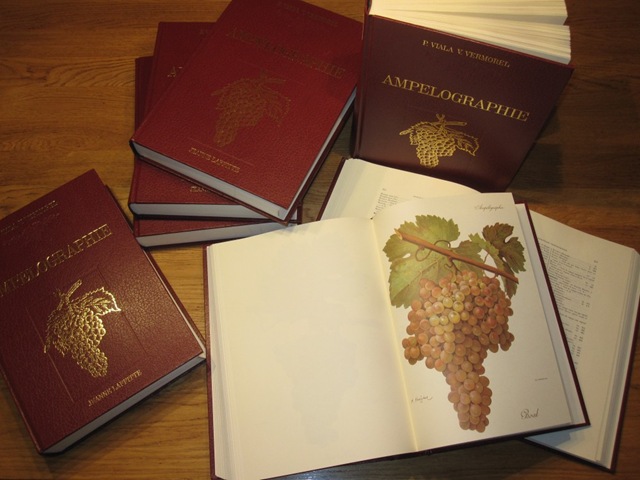
The seven volumes of the 1991 reprint by Jeanne Laffitte.
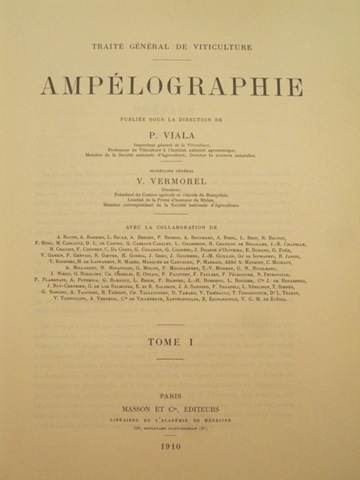
The title of Viala’s and Vermorel’s “Traité Général de Viticulture – Ampelographie”.
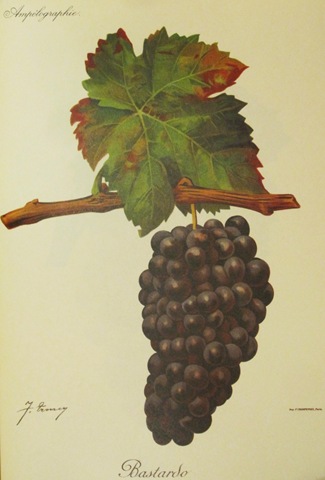
Chromolithograph of the Bastardo grape. Please note that the following chromolithographs are taken from the original 1901-1910 edition. They were all cut from the original volumes and mounted in frames, some of them slightly damaged in the process.
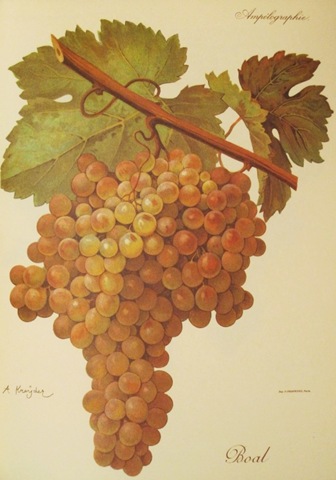
Chromolithograph of the Boal grape.
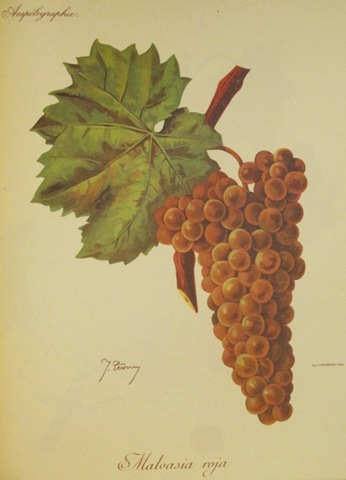
Chromolithograph of the Malvasia roja grape.
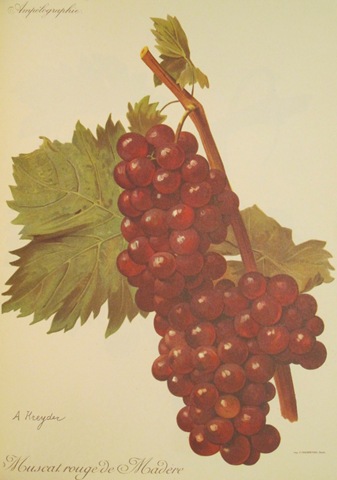
Chromolithograph of the Muscat rouge de Madere grape.
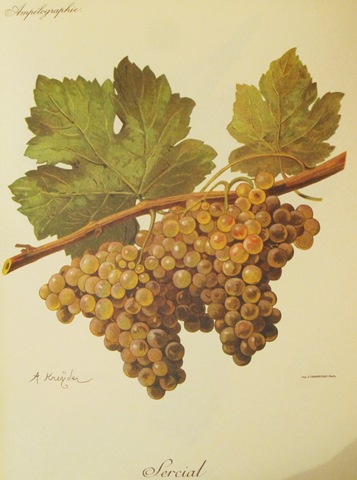
Chromolithograph of the Sercial grape.
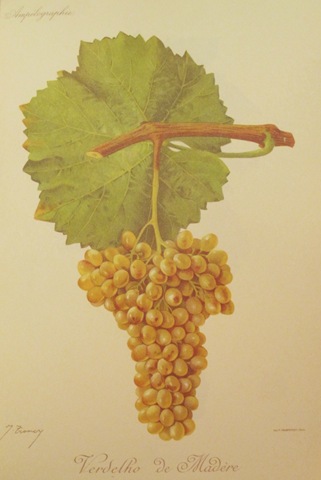
Chromolithograph of the Verdelho de Madere grape.
William Neyle Habersham and Madeira wine
In 1817 William Neyle Habersham was born into the Habersham family of Savannah, Georgia. Growing up in a wealthy and well-known family he was introduced to life’s finest things, especially Madeira wine which was undoubtedly served on a regular basis at the Habersham’s family home Avon Hall, located in Vernonburg right at the banks of the Vernon river. The Habersham family had been linked with Georgia ever since James Habersham (1712-1775) had arrived in colonial Georgia in 1738. His three sons Joseph, John and James Jr participated in the revolutionary movement and later rose to influential positions in the state of Georgia. Especially Joseph left his mark in Georgia, having Habersham County in northern Georgia named in his honour, as well as numerous sites and streets throughout the state.
So the family was well established when William Neyle Habersham was born in 1817 as the great-grandson of Joseph and the son of Robert Habersham (1783-1870). Robert had been married three times, so there was a number of ten children. Becoming a successful businessman with the company Robert Habersham and Son, Inc., of which William was a copartner with Robert Beverly Habersham, he soon made himself a name as the most precise palate of his time, especially when it came to Madeira wine. He was said to be able to blindly name a wines year, grape variety and even vineyard. In his home in Savannah the excentric merchant collected Madeira wines, treating them to the sun in a specially-built glass-house as well as fining his wines with a secret method to increase the brilliance and clarity. Some say that he invented the light and pale type of Madeira wine called “Rainwater”. But not only did he collect vast amounts of Madeira wines, he also traded them to other collectors, building up a high reputation as the source of the finest Madeira wines available. His wines would often be named after the ships that had brought them over from Madeira island or after the characteristics of the pipe that they had been stored in. Famous Habersham Madeiras were the “Hurricane Madeira”, the “All Saints Madeira”, the “Painted Pipe Madeira” and others. Besides his Madeira wine interest he was an amateur flutist and an authority on salmon fishing.
In the Civil War his business came to a stop and personal tragedy hit William Neyle and his wife Josephine (1821-1893), when both their sons Joseph Clay and William Neyle Jr. were killed in the battle of Atlanta. After the war he continued his involvement in the Madeira wine trade, selling wine from his large stocks that had been hidden away during the war to the rich and wealthy in Baltimore, Boston, Charleston, Philadelphia, New York and Savannah. Habersham died in 1899, the rest of his collection was sold at auction in 1900. His wines helped to keep alive the tradition of the Madeira parties, brilliantly described in Silas Weir Mitchell’s story “A Madeira Party”. The complete text of this well-written and somewhat ironic story can be found at this website.
It was 1959 when a group of businessmen from Savannah consisting of Thomas Gignilliat, Dr. Thomas A. McGoldrick, Dr. Peter L. Scardino, Major General Haywood S. Hansell Jr. and Dr. Antonio J. Waring formed the Savannah Madeira Club to revive the tradition of the Savannah Madeira parties. The members kept meeting until the 1990ies and their meetings would take place at a member’s home, including dinner, several Madeira wines and the discussion of a paper or a lecture presented by one of the members. In 1976 they celebrated the Bicentennial with a special Madeira party, dressing in historic clothing and re-acting a party very close to what Mitchell had described in his book.
Visitors of today’s Savannah can do a "Madeira Tour" at the Davenport House and even though Avon Hall burned down in the 1970ies there is still a slave cabin at the original site in Vernonburg and a plaque set in the brick walkway leading to Avon Hall by William Neyle Habersham.
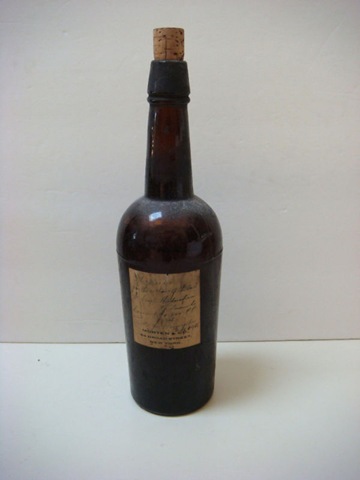
About a year ago I was able to pick up a bottle of old Madeira at auction. It had been found cleaning out the basement of an old house after the owner had died. The faded handwritten label was well legible and read: “from the cellars of the late William Neyle Habersham, Savannah, Cossart Gordon PP 1824, bottled from demijohn in 1906”. Below that comes a printed part reading “Morten & Co, 58 Broad Street, New York”. I was thrilled! Here was an original wine from one of the leading Madeira wine authorities of the 19th century America and probably of all times. And could PP be short for the famous “Painted Pipe”? After all there is at least one other bottle of “Painted Pipe” Madeira in existence, decanted, demijohned and rebottled by Morten & Co of New York in 1907 for the Vanderbilt family. However the wine merchant Ward McAllister selling this bottle claimed the “Painted Pipe” to be imported in 1790 by Newton, Gordon, Murdoch and Scott (other reliable sources like Mannie Berk say McAllister claimed the wine to be imported in 1791 by Thomas Gibbons) and now on my bottle it said 1824? But this mystery can easily be solved. As Emanuel Berk clearly shows in his brilliant expanded second edition of Noel Cossart's "Madeira - the island vineyard", the famous wines traded by Habersham "were really only blends". This does not imply that these wines weren't of the best quality. In fact being blended by the master-palate of his time, some wines were so successful that they became sought-after "brands" and so Habersham needed to re-blend considerable quantities of his famous wines again and again. After Habersham's death, his remaining wines were sold by Arnold & Co in 1900. Among the many demijohns going into sale, there was one demijohn of "Painted Pipe" carrying the date of 1824. Even though the date seems to be fictitious, it was nevertheless used in the description of the wine. So since the bottle shows the 1824 date and has been bottled from demijohn by the same New York wine merchant like the Vanderbilt bottle and since it names Cossart Gordon on the label it might well be a “Painted Pipe” wine.
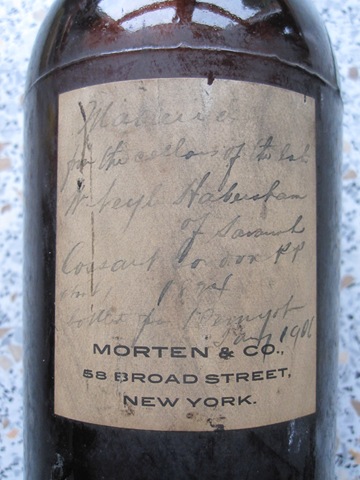
However there was another big question mark about this wine. When the bottle had been found, there had only been a small cork loosely sticking in the bottle neck, no capsule, no wax cover and the level had been low shoulder. At first the seller of this bottle wanted to throw the contents away, finding more value in the antique bottle than in the wine. I was able to convince him of putting a clean cork firmly into the bottle neck and then shipping it. Miraculously the bottle survived the transport, arriving in perfect shape.
First inspection of the bottle showed a classic three-part mold with the typical seems at the shoulder. The bottle lip had been added to the neck by the use of a lipping tool and the bottle itself was in great condition, without any cracks or chips. The label was well legible, handwritten with ink on faded paper, sticking to the glass with water-soluble glue. There were no signs of seepage on the bottle, being consistent with the bottle having been found in an upright position.
I couldn’t resist for long, so here is the tasting note from august 2011: The color of the wine is a beautifully brilliant but pale bright iodine, just like you would imagine from Habersham’s special and secret wine treatment (ok, I’m getting carried away a little here…, but the color is just amazing!), showing a hint of orange at the rim, reminding me of an old Cognac I once tasted (and did not like…). The nose offers piercing volatile acidity that makes your eyes water, lots of lovage, a little toffee, with a base layer of a slightly burned or signed buttery caramel and a hint of apricot at the end. The nose is very promising, even though the very high level of VA is rather disturbing. Finally when taking a sip all my hopes are crushed. The wine shows burning acidity, being no longer drinkable, giving a paint-thinner-like feel to the throat. Even though there is some thin and almost faded black tea taste, a hint of lemon and a woody and absolutely dry background like in an old Cognac, the wine is clearly long dead, resembling somewhat of a ghost of a once probably very good Madeira wine. So is it really the original wine? Probably yes, since in the hot climate of Savannah the Madeira wine drinkers of Habersham’s time often preferred light and dry wines that were not too sweet or too heavy. For example in the above-mentioned Arnold & Co's catalogue of Habersham's wines many Madeiras are described as pale, light or dry. And what grape variety could it be? Well, many of the wines weren’t made from a single grape variety back then. And as shown above, Habersham's wines were mainly blended wines. In the case of the "Painted Pipe" this wine had been made from 8 different Madeiras. And the wine surely tastes like a blend, lacking the individual characteristics of a single grape variety.
Even though the wine clearly does not live up to the expectations it raised, I do not regret buying that special bottle. Finding out about the history and the background of this wine was just so interesting and so much fun. I had to share this information with you and I hope you enjoy reading it.
PS: If somebody is able to supply additional information about Habersham Madeira wines, the Morten & Co company of NYC or even a picture of an old Habersham bottle, forwarding it to me is highly appreciated!
PSS: Further reading can be found at http://dlg.galileo.usg.edu/ugapressbks/pdfs/ugp9780820334479.pdf showing the complete copy of “Ebb tide” by Spencer Bidwell King Jr., a very interesting book about the diary of William’s wife Josephine Clay Habersham which she kept in 1863, with many fine drawings as well as wonderful map of the Vernon river and the surroundings of Avon Hall. Also this book offers a lot of information about the Habersham family in general.
A general overview of Robert Habersham, William’s father, can be found in complete copy at [Deprecated Link: http://library.armstrong.edu/Habersham_Robert.pdf] also offering lots of additional information on the companies associated with the Habersham family.
Finally a beautiful booklet with wonderful pictures of Vernonburg, Georgia can be found at [Depricated Link: http://www.dot.state.ga.us/informationcenter/programs/environment/resources/outreach/Documents/Publications/Vernonburg-GA-Booklet.pdf .]
Ward McAllister: Society as I have found it, 1890
As the following lines from Wikipedia will show, Samuel Ward McAllister (1827 to 1895)was certainly in a position to know a lot about Madeira wine. So reading through his book “Society as I Have Found It”, published in 1890, I came across chapter XX, loaded with knowledge about Madeira wine. Every serious Madeira wine lover should read these pages that offer a somewhat wild mixture of facts and customs related to Madeira wine. They contain a lot of Madeira wisdom in general and also enable us to have a glimpse back into American history.
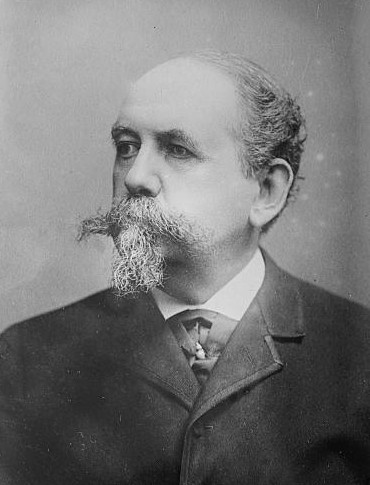
Samuel Ward McAllister (1827–1895), U.S. lawyer and social leader, picture was taken from Wikimedia Commons
Wikipedia about Ward McAllister:
Samuel Ward McAllister (December 1827 – January 31, 1895) was the self-appointed arbiter of New York society from the 1860s to the early 1890s. Born Samuel Ward McAllister to a socially prominent Savannah judicial family, he established himself as a successful attorney in California during the Gold Rush. He used the earnings from his legal prowess to journey throughout Europe’s great cities and spas—where he observed the mannerisms of the titled nobility. Upon his return to the United States, McAllister settled in New York City and married heiress Sarah Taintor Gibbons. Using his wife's wealth and his own social connections, McAllister sought to become a tastemaker amongst New York's "Knickerbocracy", a collection of old merchant and landowning families who traced their lineage back to the days of colonial New Amsterdam. McAllister's downfall came when he published a book of memoirs entitled Society as I Have Found It in 1890. The book, and his hunger for media attention, did little to endear him to the old guard, who valued their privacy in an era when millionaires were the equivalent of modern movie stars. McAllister died in disgrace while dining alone at New York's Union Club, in January 1895. His funeral, held on February 5, 1895, was well attended by many society figures of the day.
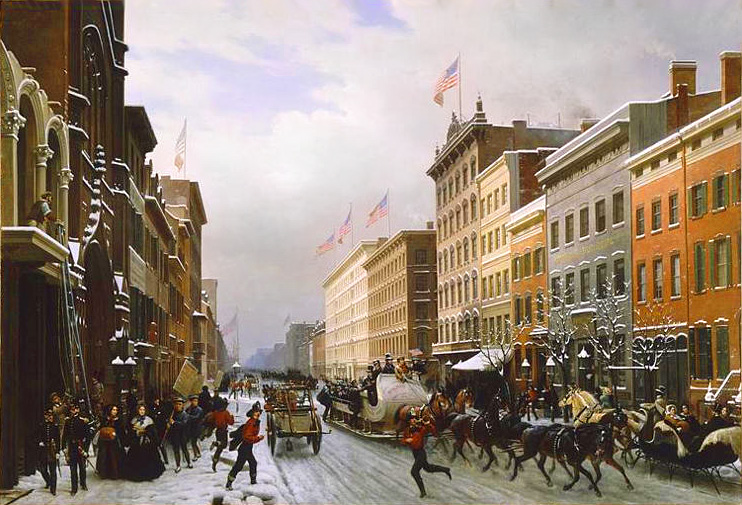
Rue de New-York en 1840 by Hippolyte Sebron, oil on canvas, picture taken from Wikimedia Commons
Excerpt from “Society as I have found it” by Ward McAllister:
Chapter XX: Madeira the King of wines – It took its name from the ship it came in – Daniel Webster and “Butler 16” – How Philadelphians “fine” their Wines – A Southern Wine Party – An Expert’s shrewd Guess – The Newton Gordons – Prejudice against Malmsey – Madeira shouldn’t be kept in the Garret – Some famous Brands
Having had your champagne from the fish to the roast, your vin ordinaire though the dinner, your Burgundy or Johannisberg, or fine old Tokay (quite equal to any Johannisberg), with the cheese, your best Claret with the roast, then after the ladies have had their fruit and have left the table, comes the king of wines, your Madeira; a national wine, a wine only well matured at the South, and a wine whose history is as old as that of our country. I may here say, that Madeira imparts a vitality that no other w2ine can give. After drinking it, it can act as a soporific, but the next day you feel ten years younger and stronger for it. I have known a man, whose dinners were so famous by reason of his being always able to give at them a faultless Madeira, disappear with his wine. When his wine gave out, he collapsed. When asked, “Where is Mr. Jones?” the ready answer was always given, “He went out with his ‘Rapid’ Madeira.”
Families prided themselves on their Madeira. It became an heirloom (as Tokay now is, in Austria). Like the elephant, it seemed to live over three score years and ten. The fine Madeiras were fine when they reached this country. Age improved them, and made them the poetry of wine. They became the color of amber and retained all their original flavour. But it is an error to suppose that age ever improved a poor Madeira. If it came here poor and sweet, it remained poor and sweet, and never lost its sweetness, even at seventy or eighty years, while the famous Madeiras, dating as far back as 1791, if they have been properly cared for, are perfect to this day. We should value wine like women, for maturity, not age.
These wines took their names generally from the ships in which they came over. There is no more sensitive wine to climatic influences. A delicate Madeira, taken only a few blocks on a cold, raw day, is not fit to drink; and again, you might as well give a man champagne out of a horse bucket, as to give him a Madeira in a thick sherry or claret glass, or a heavy cut glass. The American pipe-stem is the only glass in which Madeira should be given, and when thus given, is, as one of our distinguished men once said, “The only liquid he ever called wine.” This ought to be given as was done by the Father of the Roman Lucullus, who never saw more than a single cup of Phanean wine served at one time at his father’s table.
A friend of mine once gave the proprietor of the Astor House, for courtesies extended to him, a dozen of his finest Madeira. He had the curiosity years after to ask his host of the Astor house what became of his wine. He replied, “Daniel Webster came to my house, and I opened a bottle of it for him, and he remained in the house until he had drunk up every drop of it.” This was the famous “Butler 16.”
As in painting there are the Murillo and Correggio schools, the light and ethereal conceptions of womanhood, as against the rich Titan coloring; so in Madeira, there is the full, round, strong, rich wine, liked by some in preference to the light, delicate, straw-colored, rain-water wines. Philadelphians first took to this character of wine. They judiciously “fined” their wine, and produced simply a perfect Madeira,-to be likened to the best Johannisberg, and naturally so, it having similar qualities, as it is well known that the Sercial Madeira, the “king pin” of all Madeiras, was raised from a Rhine grape taken to the island of Madeira. And here let me say, that “fining,” by using only the white of a perfectly fresh egg and Spanish clay, is proper and judicious, but milk is ruinous. The eggs in Spain are famous, and are thus used.
In Savannah and Charleston, from 1800 up to the Civil War, afternoon wine parties were the custom. You were asked to come and taste Madeira, at 5 P.M., after your dinner. The hour of dining in these cities was then always 3 P.M. The mahogany table, which reflected your face, was set with finger bowls, with four pipe-stem glasses in each bowl, olives, parched ground nuts and almonds, and half a dozen bottles of Madeira. There you sat, tasted and commented on these wines for an hour or more. On one occasion, a gentleman, not having any wine handy, mixed half “Catherine Banks” and half “Rapid.” On tasting the mixture, a great wine expert said if he could believe his host capable of mixing a wine, he would say it was “half Catherine Banks and half Rapid.” This was after fifteen men had said they could not name the Madeira.
A distinguished stranger having received an invitation to one of these wine parties from the British Consul, replied, “Thanks, I must decline, for where I dine I take my wine.”
The oldest and largest shippers of Madeira were the Newton Gordons, who sent the finest Madeiras to Charleston and Savannah. From 1791 to 1805, their firm was Newton Gordon, Murdock, & Scott. One hundred and ten years ago, they sent five hundred pipes of Madeira in one shipment to Savannah. These wines sent there were the finest Sercials, Buals and Malmseys. All these wines were known as extra Madeiras. The highest priced wine, a Manigult Heyward wine, I knew forty years ago; it was ninety years old-perfect, full flavoured, and of good color and strength. In Charleston and Savannah from 1780 to 1840, almost every gentleman ordered a pipe of wine from Madeira. I know a man who has kept this up for half a century.
There is a common prejudice against malmsey, as being a lady’s wine, and sweet; when very old, no Madeira can beat it. I have now in my cellar an “All Saints” wine, named after the famous Savannah Quoit Club, imported in 1791; a perfect wine, of exquisite flavour. My wife’s grandfather imported two pipes of Madeira every year, and my father-in-law continued to do this as long as he lived. When he died he had, as I am told, the largest private cellar of Madeira in the United States. All of his wines were Newton Gordons. He made the fatal mistake of hermetically sealing them in glass gallon bottles, with ground glass stoppers, keeping them in his cellar; keeping them from light and air, preventing the wine from breathing, as it were. It has taken years for them to recover from this treatment.
Madeira should be kept in the garret. A piece of corn cob is often a good cork for it. Light and air do not injure it, drawing it off from its lees occasionally, makes it more delicate, but if done too often, the wine may spoil, as its lees support and nourish it.
The great New York Madeiras, famous when landed and still famous, were “The Marsh and Benson, 1809,” “The Coles Madeira,” “The Stuyvesant,” “The Clark,” and “The Eliza.” In Philadelphia, “The Butler, 16.” In Boston, The “Kirby,” the “Amory 1800,” and “1811,” “The Otis,” In Baltimore, “The Marshall,” “The Holmes Demijohn,” “The Mob,” “The Colt.” In Charleston, “The Rutledge,” “The Hurricane,” “The Earthquake,” “The Maid,” “The Traddstreet.” In Savannah, “The All Saints” (1791), “The Catherine Banks,” “The Louisa Cecilia” (1818), “The Rapid,” 1817, and “The Widow.”
PS: To my knowledge there is no copyright on "Society as I have found it", especially not in this 1890 version. Since it was published before January 1st, 1923 I believe it has entered the public domain. But should you know of any still existing copyright please inform me using my email-address from the chapter "Introduction" or the forum. I used the original text layout and all the typos are exactly from the original (or so I hope).
Your Madeira Wine Library
When you start getting serious about collecting Madeira wine, of course you start collecting some books about Madeira wine as well. Besides a duo of absolute must-have basics, there are more books about the historical background, society, economics and so on. In this chapter I will try to give you an overview about the available books about Madeira wine. It is of course my personal view, but those books have really been helpful over the years, so you might consider taking a closer look at them.
The must-have duo of basics about Madeira wine
Noel Cossart: Madeira the island vineyard, 1984, Christie’s Wine Publications, 2011 Rare Wine Co and Alex Liddell: Madeira, 1998, Faber and Faber Limited, 2014 Hurst & Co. If you only ever own two books about Madeira wine, these two would be it. While Cossart’s book was certainly the best Madeira publication for the 1980ies, Liddell’s book became the same for the 1990ies. Both books have made a glorious comeback. Emanuel Berk has re-edited Cossart’s Madeira the island vineyard with lots of new material in 2011 and published this second edition through his Rare Wine Co., Sonoma, California. Three years later Alex Liddell had also revised his book and published this second and expanded edition of Madeira the mid-atlantic wine with Hurst & Co in 2014. While it is certainly interesting to own the originals from 1984 and 1998, I would advise you to get the second editions, since they contain lots of new material. They are also meticulously revised to reflect the many changes on Madeira island and in the Madeira wine business.
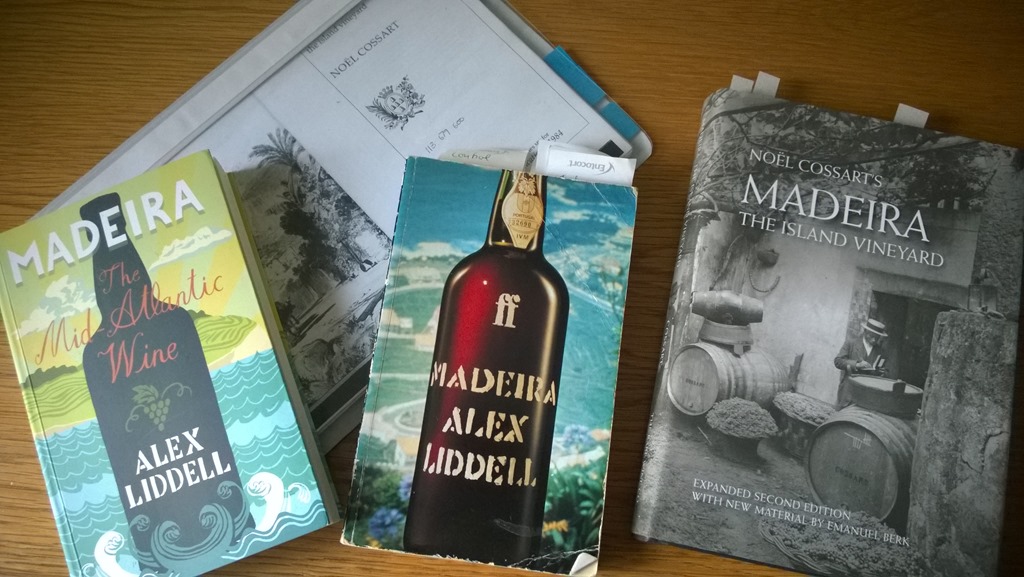
The two books perfectly complement one another, since they are totally different in style. Island vineyard offers a lot of basic Madeira wine knowledge but is also a colorful collection of stories about the wine, the involved people, the anecdotes about the different famous wines and so on. Alex’ book takes the more scientific approach. The author’s background as a university lecturer certainly shows in the love for detail and the reliable facts that are abundant in this publication. It might not be as entertaining as Island vineyard, but it certainly is a fluent read. It must be said, however, that Mannie Berk has added a wealth of new material to the second edition of Cossart’s book and this brings a lot of ‘gravitas’ to the book. Both authors cannot be praised enough for putting so much effort into their publications, especially when you consider the fact that Madeira wine is still a niche market.
The duo about the social and historical background of Madeira wine
Marcus Binney: The Blandys of Madeira 1811-2011, 2011, Frances Lincoln is the basic book about one of the most influential families on Madeira island. The Blandys have not only been involved in the wine trade, but also in travel, trade in general, banking and even the famous Reid’s hotel. The book spans two centuries starting with John Blandy arriving on Madeira island early in 1808 and ending with a wonderful picture of the Blandy family at Palheiro. If you want to understand Madeiran society, there is no read like Binney’s book.
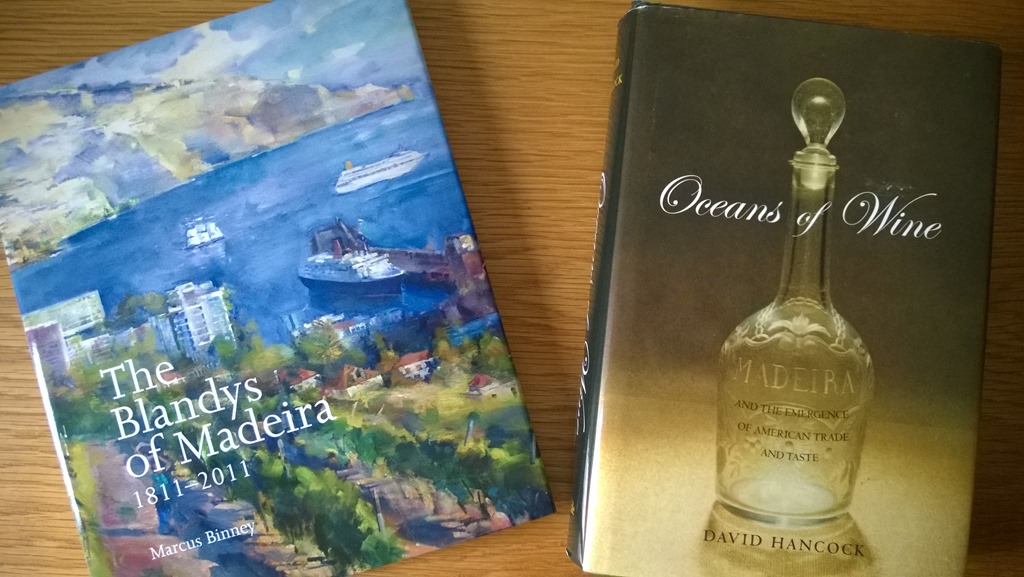
David Hancock: Oceans of Wine, 2009, Yale University Press is a certainly herculean effort. This publication gives a very complete overview about the trans-Atlantic wine trade in the 17th and 18th century. On 600+ pages David gets into every detail, from wine-making and trading to drinking habits, he has it all covered - the index alone has 40 pages! Coming from a scientific background myself, I like the fact that this book is abundant with notes (160 pages of them) that enable you to look up sources for further reading. Some of the notes are so extensive themselves that you could have made additional chapters of them.
The quick access to Madeira wine
Trevor Elliot: The wines of Madeira, 2010, Trevor Elliot Publishing. If you ever wanted to read a fast and easy book for the quick access to Madeira wine, look no further. Trevor Elliot’s book offers a complete overview, but in a very condensed fashion. It is the ideal refresher to read while travelling to Madeira island. But the real value lies in the many and beautiful pictures in the book. Every time I flip through the pages, the pictures make me want to go back to the island, or at least open a bottle of Madeira wine.
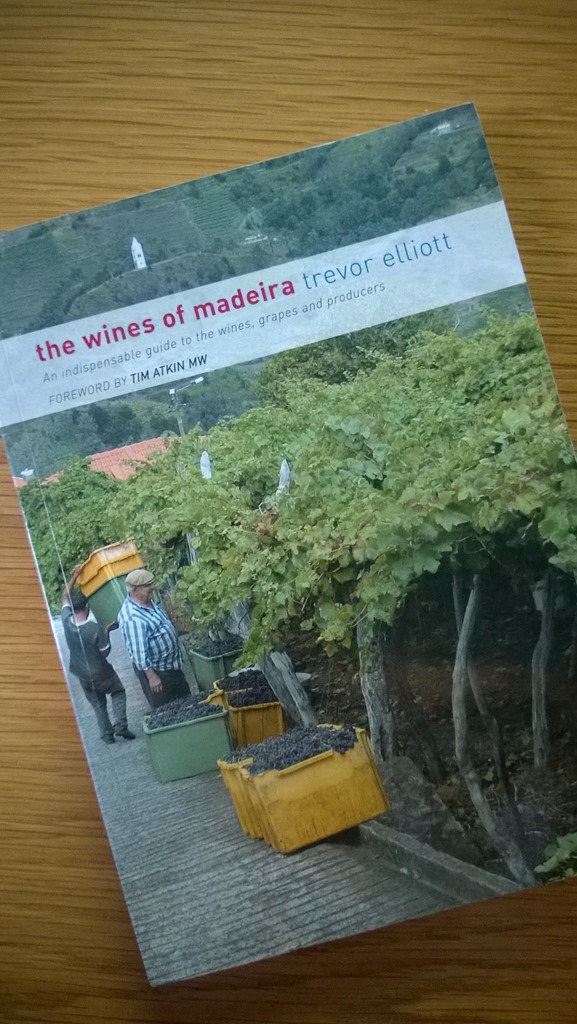
The American interest in Madeira wine
Emanuel Berk: A century past, a celebration of the Madeira party in America, 1999, The Rare Wine Co, Sonoma, California. In this booklet, Mannie gives an overview about Madeira wine collecting, Madeira Parties and the last of the great nineteen-century Madeira parties, hosted by Douglas H. Thomas. The publication makes you understand just how important Madeira wine was in social life in the United States.
John P. Cann: The Madeira heritage in colonial America, 2003, reprinted by the Rare Wine Co. Another short, but very interesting read into the early American Madeira customs.
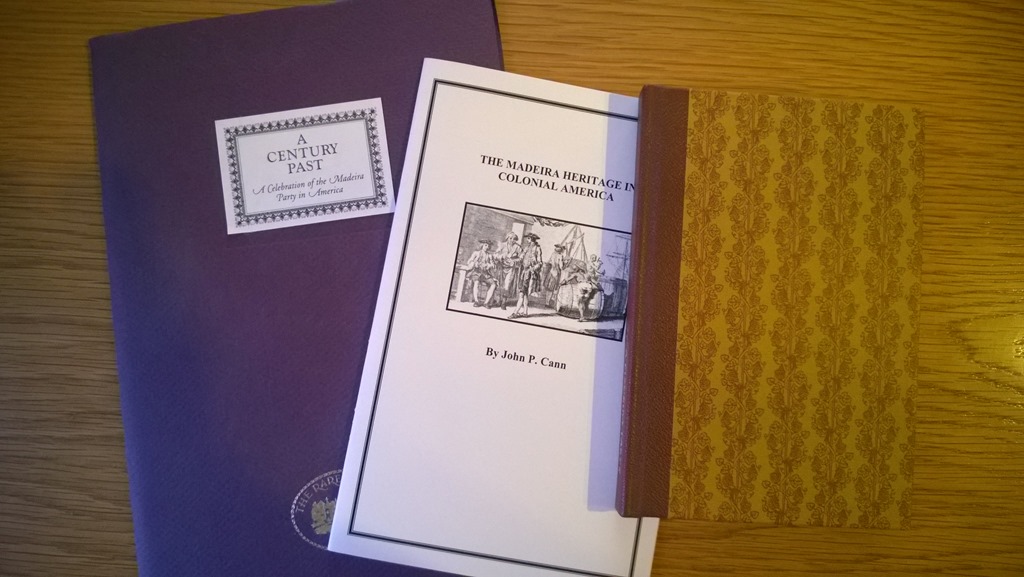
A Silas Weir Mitchell: A Madeira Party, reprint 1975, Corti Brothers, Sacramento. The best ever and most accurate description of a typical American Madeira wine party, written in a humorous and slightly sarcastic way and very entertaining. This reprint also contains an essay on Silas Weir Mitchell and a very interesting essay on "Our Madeira Tradition" by Roy Brady.
Other books I would like to recommend
Rupert Croft-Cooke: Madeira, 1961, Putnam, London. This is an old but complete book about Madeira wine from the 1960ies’ British perspective.
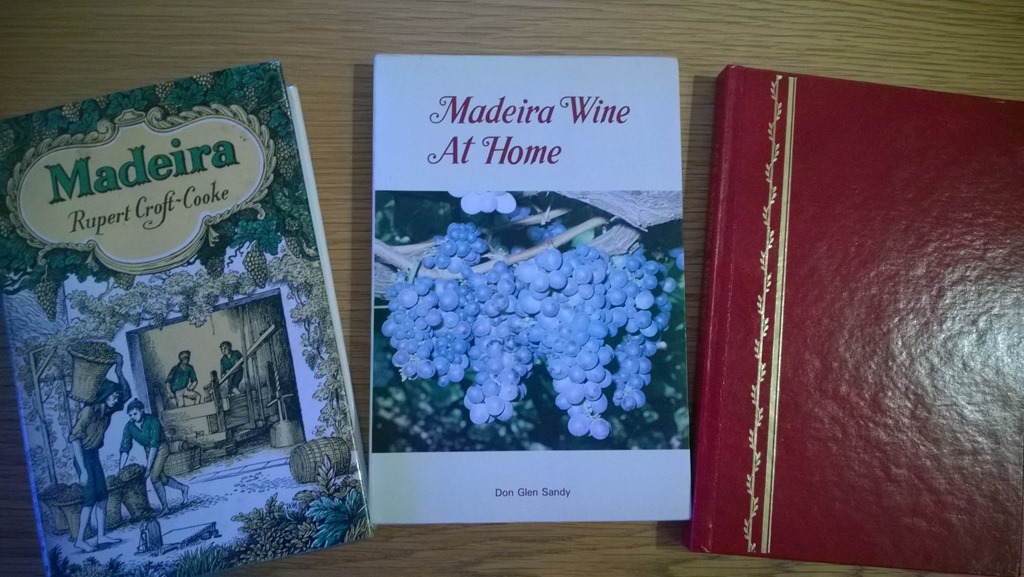
Don Glen Sandy: Madeira wine at home,1988. The author had been editor of the Madeira Island Bulletin since 1978 and gives a somewhat wild mixture of facts, stories and recipes about Madeira wine. This book is a roller-coaster ride, but a very interesting read nevertheless.
F. William Sunderman: Our Madeira Heritage, 1979, Institute for Clinical Science, Inc., Philadelphia. Doctor Sunderman offers a wide description of Madeira wine in general and the American Madeira heritage. His book also contains Silas Weir Mitchell’s story A Madeira Party and the lyrics of Have some Madeira m’dear.

You must be logged in to post a comment.